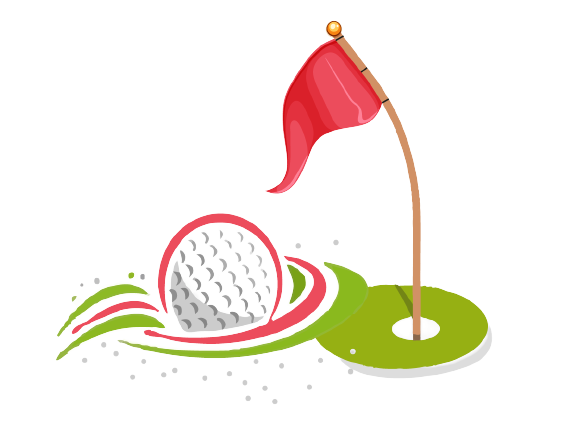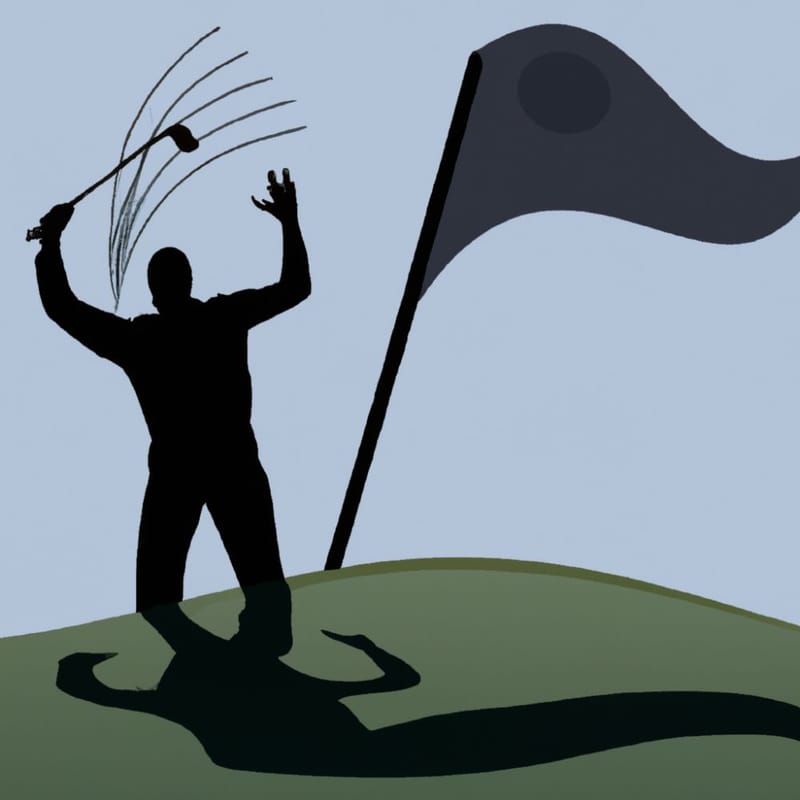Content Summary
Have you ever wondered why some golfers succeed with a majestic, towering ball flight while others excel with a subtle, penetrating draw? As I navigate the fairways and greens, pursuing the elusive perfect round, I find that my greatest fault/weakness is a too-steep downswing causing an over-the-top swing.
Learning from the insights of tour pros and golf gurus alike, I've delved deep into the dichotomy of the steep vs shallow golf swing. The debate on golf swing techniques is robust and, now, you're about to discover how the golf swing plane variations and that optimal backswing angle could be the linchpin to upgrading your game.

Pros and Cons of Stack and Tilt Golf Swing
Key Takeaways
- Understand the crucial differences between a steep and a shallow golf swing and how they affect your game.
- Learn about well-known golfers who have mastered either a steep or shallow swing and how it complements their playstyle.
- Explore the benefits and drawbacks of both swing planes to assess which might suit your game best.
- Delve into how swing plane variations impact ball trajectory, divot size, and angle of attack.
- Grasp the significance of the optimal backswing angle and its effect on your overall performance.
Introduction to Swing Planes
When I first tackled the perplexing world of golf, the difference between steep and shallow swings seemed as mystifying as choosing the right club on a blustery windy day. Let's dive in, fellow golf enthusiasts, as I demystify the concept of golf swing angles and their significant roles in shaping our game.

Golf Warm Up Drills
Imagine your swing as a masterpiece in motion, the brush being your club, and the canvas the vast expanse of the green. A steep swing is akin to a confident, vertical stroke, the club shaft almost perpendicular at its peak, before plunging in a spirited thwack on the unsuspecting golf ball. This dramatic motion creates the steep angle renowned for pinpoint accuracy but a heightened risk of an overzealous dig into the turf.
In contrast, the shallow swing is the artist's sweeping curve, where the club shaft lies in a more relaxed, horizontal plane. This is the graceful dance around the body, the genteel embrace of the ball before sending it skywards. It's an approach centered on finesse, often resulting in a longer, more serene ball flight.
Now, let's commit to our memories a handy tableau that contrasts the steep and shallow swings in the realm of golf:
| Aspect | Steep Swing | Shallow Swing |
|---|---|---|
| Motion Trajectory | Vertical | Horizontal |
| Angle of Attack | Negative | Positive |
| Divot Depth | Deep | Shallow |
| Clubhead Motion | Direct Downward Strike | Around-The-Body Motion |
| Resulting Trajectory | High backspin, Lower flight | Lower backspin, Higher flight |
By comprehending these distinct swing planes, I've realized that being adept at both can unlock new potentials on the course. Whether you're navigating a treacherous bunker or aiming for the green, understanding the quintessential golf swing angles is your first step toward elevating your game.

Senior Golf Swing
The Mechanics of a Steep Golf Swing
The intricacies of a steep golf swing are both fascinating and critical to mastering the game's challenges. By delving into the components that make up this swing style, golfers can discover areas where they can enhance their technique. So, let's explore the defining character of the steep swing—the vertical shaft angle—and how it impacts our golfing prowess.
Understanding the Vertical Shaft Angle
What sets a steep swing apart is the pronounced vertical shaft angle during the downswing. This motion results in the club moving sharply up and down, akin to a pendulum, which is central to generating a negative angle of attack as the clubface meets the ball. Visualizing this vertical path is crucial for improving a steep swing, as it dictates how the ball will react upon impact.
In this video will find a drill you can use to shallow the club. Position and tempo are important ingredients to any good golf swing for many golfers. Also, a good instructor can be a great help in improving your golf.
Deep Divots and Angle of Attack
When we speak of a steep swing, it often results in deep divots—a telltale aftermath of a steep, negative angle of attack. Hitting down on the ball might offer a satisfying thwack on the turf, but it's not just about the sound; it's the interplay between club, ball, and ground that shapes the shot's success. Golfers who master this aspect can create forceful impacts that are ideal for certain lies, though it's also essential to avoid digging in too deeply, which can hinder the shot.
Notable Players with Steep Swings
In the pantheon of golfers, some stand out for their adoption of the steep swing. Legends like Hale Irwin have demonstrated the power and precision that comes with this style. On the other hand, contemporary golf stars such as Justin Thomas and Branden Grace showcase how a modern steep swing can dominate today's game. Their exemplary execution of sharp upward and downward motion serves as an inspiration for those looking to refine a steep swing path.
| Golfer | Angle of Attack | Notable Achievements |
|---|---|---|
| Hale Irwin | Negative | 3-time U.S. Open Winner |
| Justin Thomas | Negative | PGA Championship Winner |
| Branden Grace | Negative | Multiple European Tour Wins |
Exploring the Shallow Golf Swing
When I began analyzing my golf game, I quickly realized that understanding the shallow golf swing was crucial for improving my play. By embracing a shallower swing, I intended to mimic the prowess of pros like Jon Rahm, Lee Trevino, and Matt Kuchar, who have mastered the art of this technique.
Horizontal Shaft Angle Dynamics
The biomechanics of a shallow golf swing captivated me as I discovered its reliance on a more horizontal shaft angle throughout the swing. This trajectory, wrapping around the body, elegantly reduces vertical lift and mitigates divot depth—a stark contrast to the chunky marks left by steep swings.
Pros of a Positive Attack Angle
What stood out to me was the positive angle of attack associated with shallow swings. By facilitating less backspin and shallower divots, not only did I notice an improvement in ball flight, but I also enjoyed a more forgiving impact, less prone to jarring errors that could rattle my confidence.
Professional Golfers Known for Shallow Swings
My inspiration came from observing golf greats renowned for their shallow swings. Jon Rahm's fluidity, Lee Trevino's precision, and Matt Kuchar's consistency provided a blueprint for fixing shallow swing issues and unlocking a graceful power that can redefine a golfer's game.
- Jon Rahm's finesse and controlled takeaways.
- Lee Trevino's iconic fade, crafted by a beautifully horizontal swing.
- Matt Kuchar's remarkably stable head and spine angles throughout his swing.
| Golfer | Angle of Attack | Signature Swing Feature |
|---|---|---|
| Jon Rahm | Positive | Powerful yet controlled takeaways |
| Lee Trevino | Positive | Mastery of the fade |
| Matt Kuchar | Positive | Steady head and spine alignment |
The Pros and Cons of a Steep Swing
As I dive deeper into golf mechanics, it becomes clear that the best swing path for golf often depends on the player's individual scenario. A steep swing can certainly have its advantages, especially when you find yourself in the clutches of the rough.
The likelihood of a clean strike is notably higher, as the steeper path tends to cut through the grass with less interference—a boon for accuracy under pressure. However, every coin has two sides, and so does the steep swing.
Conversely, the challenges of a steep vs shallow golf swing come into play when the clubhead comes down on the ball with a sharper descent. This can result in increased mishits like slices and pulls, which can derail the game quickly.
And let’s not forget about using the driver—a steep path can significantly raise the level of difficulty, often translating into less forgiving shots and more frequent visits to the hazards lining your fairways.
| Benefits of a Steep Swing | Challenges of a Steep Swing |
|---|---|
| Cleaner contact in the rough | Inclination for mishits such as slices and pulls |
| Less grass interference on strike | Inconsistent driver performance |
| Higher potential spin rate | Harder shot-making with long irons and woods |
My journey to mastering golf continues, reminding me that each swing style possesses its unique flavor of pros and cons. Perfection might be elusive, but understanding the nuances of the steep vs shallow golf swing is the first step toward adapting my game to the best swing path for golf, pushing me closer to that illustrious sweet spot of technique and success.
Advantages and Disadvantages of Shallowing Your Swing
As I delve deeper into the quest for the best swing path for golf, I've explored the notion of shallow versus steep golf swing techniques. Shallowing your swing offers a unique set of benefits and challenges that could reshape your game. Let's chip away at what these are and how they can affect your performance on the course.
Improved Distance and Shot Trajectory
I’ve found that tweaking my swing to a more shallow path has increased the distance of my drives. By reducing the golf swing angles and creating a more horizontal swing plane variation, my shots have gained that coveted sweeping motion.
The adjustments lead to less backspin and these moderate divots help to maximize the efficiency of energy transfer to the ball, thus enhancing shot trajectory. This optimized path often translates into those extra yards that can make a difference on the fairway.
Potential Drawbacks to Consider
Although I've seen improvements with a shallower golf swing, there are potential pitfalls to keep in mind. This technique can lead to thin or fat shots, where the club either skims the surface or digs too deeply into the turf before hitting the ball.
For golfers not used to a shallow swing, errant shots, such as blocks to the right, can become a frequent annoyance. With reduced vertical motion, I've also had to adjust my approach with shorter irons and wedges, where a steeper swing might be more effective.
Excessively shallow swings can lead to hooks, a scenario where the ball dramatically curves to the left, a clear sign to reassess the balance between steep vs shallow golf swing practices.
Understanding the differences between golf swing plane variations and how they materialize in performance is key. Each golfer’s swing is as unique as their fingerprint, and finding the most suitable path takes practice and adjustment. A blend of the ideal characteristics of both steep and shallow swings might just mark the sweet spot we're all striving to hit.
Steep vs Shallow Golf Swing
When I delve into the nuances of the steep vs shallow golf swing, I consider not only my style but the specific physiological demands of either technique. For golfers who savor a bolder and more direct route to the ball, the steep swing might just be the ticket.
However, for my fellow players seeking finesse and a nuanced command over their shots, the shallower swing could be a game-changer. Both techniques come with their own set of challenges and advantages that, when understood and leveraged correctly, can catapult one's golfing prowess to new heights.
Shallow Golf Swing Drills
Let's take a moment to distill the difference between steep and shallow swings through a comparative lens. The steep swing is synonymous with a 'chop down' effect on the ball, appealing to those who don't shy away from an assertive angle of attack. Conversely, the shallow swing resembles a graceful arc, a friend to those who prefer consistency over force. Below is a table that demarcates the key distinctions between these two swing planes.
| Swing Type | Angle of Attack | Divot Depth | Ball Spin | Common Challenges |
|---|---|---|---|---|
| Steep Swing | Negative | Deep | Higher | Slices/Pulls |
| Shallow Swing | Positive | Shallow | Lower | Thins/Hooks |
I know firsthand that every golfer's swing is as distinct as their signature. On this journey to refine my swing, the goal has been to strike a harmony between steepness and shallowness. It's about harnessing the best of both worlds to suit my play style. Whether it's understanding the minutiae of the swing plane or harnessing the right angle of attack, I embrace each round as an opportunity to learn and improve—a pursuit that never quite ends, much like the game of golf itself.
Tips for Adjusting Your Swing Plane
If you're looking to fine-tune your golf swing, focusing on the swing plane is essential. Let me walk you through a couple of key adjustments that can have a profound impact on your game.
Assessing Your Takeaway and Wrist Hinge
One of the first areas I look at is the takeaway. A wide, smooth takeaway sets you up for success, and it's where having good wrist hinge comes into play. You want to hinge your wrists upwards, not towards you, to maintain a proper swing path. Practicing this can make a significant difference to the overall angle and consistency of your swing plane.
Using Ground Force to Your Advantage
I've also found that using ground force can yield great rewards. Initiating your downswing with a drop in your lead hip allows you to leverage ground force effectively. It might feel like a small move, but it generates immense power and consistency. Here's a breakdown of how I incorporate this technique:
- Start the downswing with your lead hip moving downwards, engaging the ground force.
- Smoothly shift your weight to the front foot while keeping your back foot rooted.
- Rotate your hips fully towards the target as you enter the impact zone.
This sequence is supported by the physics behind expert golf swing techniques, showing that a golfer can really harness the ground to boost power and control. It's amazing how these small adjustments to your swing mechanics can dramatically enhance your game.
| Technique | Effect on Swing Plane | Impact on Ball Contact |
|---|---|---|
| Proper Wrist Hinge | Establishes a consistent swing angle | Improves ball striking accuracy |
| Engaging Ground Force | Creates a shallower downswing path | Generates power for more distance |
Conclusion
In the quest to master the golf swing, the debate between a steep vs shallow golf swing is often at the forefront of a golfer's technical choices. As someone deeply passionate about golf, I've devoted considerable time to dissecting both techniques and have uncovered compelling reasons to advocate for each.
It's critical to acknowledge that while a steep swing can manifest remarkable precision under certain conditions, its aggressive nature isn't suited for all playing scenarios. Conversely, a shallow golf swing has the potential to offer unparalleled consistency and finesse, elements that frequently translate into lower scores and improved play from tee to green.
The crux of enhancing your game lies in a thorough understanding of golf swing techniques and recognizing the best swing path for golf that complements your natural style. The precision of a steep swing may entice golfers facing dense rough or seeking a sharp, descending blow, yet its drawbacks are worthy of consideration. Alternatively, golfers seeking fluidity and a more forgiving contact point might find solace in the finesse of a shallow swing, all without sacrificing distance or flight trajectory.
Ultimately, my journey through the art of golf has led me to a simple truth: there is no one-size-fits-all solution. Your unique swing is a tapestry woven from personal preference, physical capability, and strategic gameplay.
Whether you lean towards a steep or shallow approach, the secret to unlocking an optimal performance resonates in the deliberate refinement of your chosen path. Embrace the nuances of each swing style and dedicate time to practice and experimentation—because at the end of the day, the best swing path for golf is the one that brings you confidence and joy on the course.
Steep vs Shallow Golf Swing FAQ
What is the difference between a steep and shallow golf swing?
A steep golf swing refers to a swing where the club approaches the ball on a steeper angle, leading to a more vertical downswing. On the other hand, a shallow golf swing involves a flatter approach to the ball, with the club traveling on a shallower angle.
How does the angle of attack differ in a steep vs shallow swing?
In a steep swing, the angle of attack is much steeper, meaning the club head comes down more vertically onto the ball. In contrast, a shallow swing has a shallower angle of attack, where the club head approaches the ball more horizontally.
What are the common impact on shots between a steep and shallow swing?
A steep swing often leads to lower, spinning shots with less distance, while a shallow swing can result in higher, longer shots with more carry.
How can a golfer shallow their swing to improve performance?
To shallow the swing, a golfer can focus on starting the downswing with the lower body, allowing the club to drop into a shallower plane, or use training aids like alignment sticks to help understand and practice shallowing the swing path.
Is it better to have a steep or shallow swing for hitting longer shots?
Generally, a slightly shallower swing can help golfers achieve longer shots as it promotes a more ascending strike on the ball, leading to higher launch angles and increased distance.
How does the angle of the club shaft change between a steep and shallow swing?
In a steep swing, the club shaft tends to be more vertical at impact, whereas in a shallow swing, the club shaft is more horizontal, reflecting the different swing planes.







